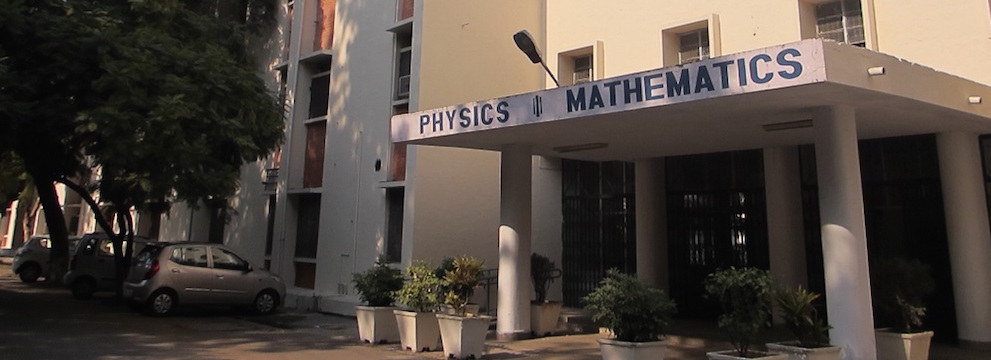
Engineering Physics
In the same building as the Mathematics department and bears an uncanny resemblance to the same: Both these departments take in young geeks having a JEE rank that could not grant them civil or chemical; and turn them into young geeks who regret having a JEE rank that could not grant them civil or chemical. The entrance to the Physics department is also regarded by many as a wormhole hidden in plain sight: transporting unsuspecting entrants from a world of joy, togetherness and bun-samosas to one of misery, practical records and where you can’t talk inside laboratories.
Course Structure
In it’s second year of offering, the structure of the undergraduate engineering physics course offered at Roorkee consists of a package of standard undergraduate physics courses, designed to give a rudimentary understanding of most of the basic and popular areas of physics research to the students. Studies deal with condensed matter physics, optics, nuclear physics, atmospheric and atomic physics. Recent changes have been reflected in new courses being floated,such as those in astrophysics, space technology, nanosystems, biophysics and quantum optics.
However this being an engineering course rather than the earlier theoretical physics one, the traditional physics courses are bundled along with relevant courses from other disciplines such as those in Signals and Systems, Microprocessors and Peripheral Devices and Semiconductor Devices. Students have the option of deviating even further from the conventional by taking up elective courses such as Digital Image Processing, Data Structures, Remote Sensing, and Digital Signal Processing in their third or fourth years.
However, it is not all about the flashy courses that you can do in your ultimate or penultimate year. Physics research is usually bottom up, and any researcher is expected to have a good understanding of physical theories such as special relativity, electromagnetism, quantum theory and classical mechanics. Students are supposed to take a number of compulsory courses in these, besides the whole shebang of specialized courses in condensed matter physics, nuclear physics, atomic and laser physics. Also, physics researchers are expected to have a sound understanding of the mathematics of the physical theories that they will tackle, and students are supposed to do compulsory courses or opt for electives, in mathematics. Calculus and linear algebra are vital and covered in the first two years, and more advanced topics are covered in the a mathematical physics course. There are also lab courses offered later, with specialized labs in the final year. They, however, leave much to be desired.
The department also offers courses in computational physics, which is vital to the skill set of any physics researcher. Languages such as MatLab, Mathematica and Fortran are usually taught, and students are taught to formulate and solve physical problems numerically. In the wider program of physics research, this has become increasingly important as both experimental and theoretical studies are turning to numerical calculations as a research tool.
Fields of Research
Roorkee’s physics department has traditionally been a theoretical stronghold. We have a number of experienced faculty specializing in nuclear physics, condensed matter physics, atmospheric science and atomic physics. The new faculty has brought in experience in fields such as astrophysics, biophysics and solar cell research. There is an upcoming cutting edge lab in quantum optics, supposed to be operational soon, that is expected to produce quality experimental research once working. Students, especially undergraduates, have been known to participate in the department’s research activities. Undergraduates are usually not expected to do research, but there have been instances of students collaborating and even taking the lead on projects leading to publications. The department is usually forthcoming to such initiatives on the student's’ part.
Internship opportunities
Students, especially undergraduates, have ample opportunities to participate in active research during their summer and winter breaks. Back when IITR used to offer an MSc. Physics course, a number of summer fellowships have been awarded to students to work at prestigious universities and research institutions, both in India and abroad. Many senior students work with the researchers of their choice over the breaks, where they are exposed to an intensive research environment, experience they bring home to the benefit of their fellow students. There have been participants in exchange programs like the WISE (DAAD Germany), the SN Bose Scholars Program (USA) and the Mitacs Globalink Program (Canada), and other fruitful exchanges with some European universities. A number of students also participate in the IAS fellowship program, where they are paired with a leading researcher at an Indian university or institute for the summer. It is also common for students to participate in summer and winter schools and camps in specialized topics. A testament to the efficacy of such programs has been the number of publications that have come out of these projects, assuring us that the students have been exposed to quality research. This experience is vital in helping the undergraduates make an informed choice when opting for graduate school. A great experience working in the lab, or on theoretical or numerical projects has persuaded a number of skeptical students to opt to go to graduate school.
Opportunities after
Opportunities for students after graduation are varied. On the physics front, a doctorate degree is a necessity if the students want to be researchers. With the right profile, a Roorkee graduate can make it to top schools in the US and Europe. Recent graduates have made it to top Ivy League schools, and best research groups in Europe. It is also common for students to get graduate positions at top Indian research institutes. The curious mix of courses taught at Roorkee prepares well, the graduating students for life ahead as a physics researcher.